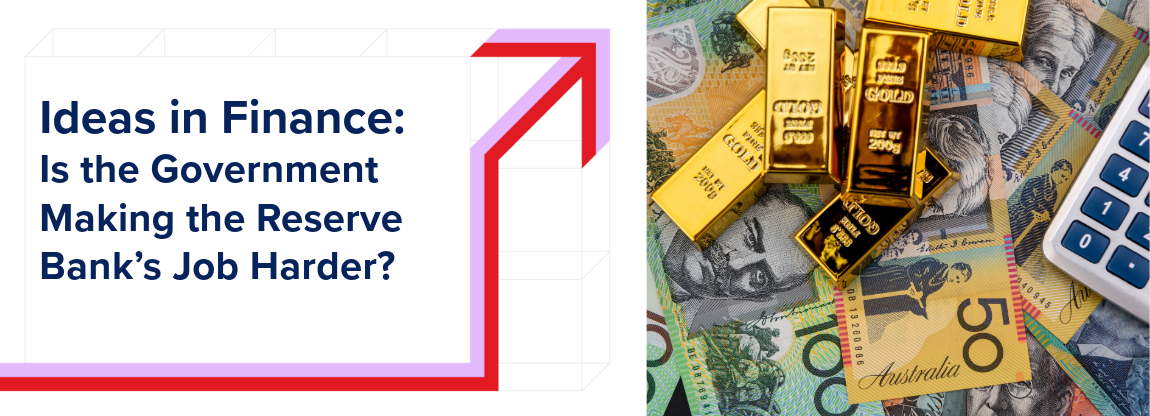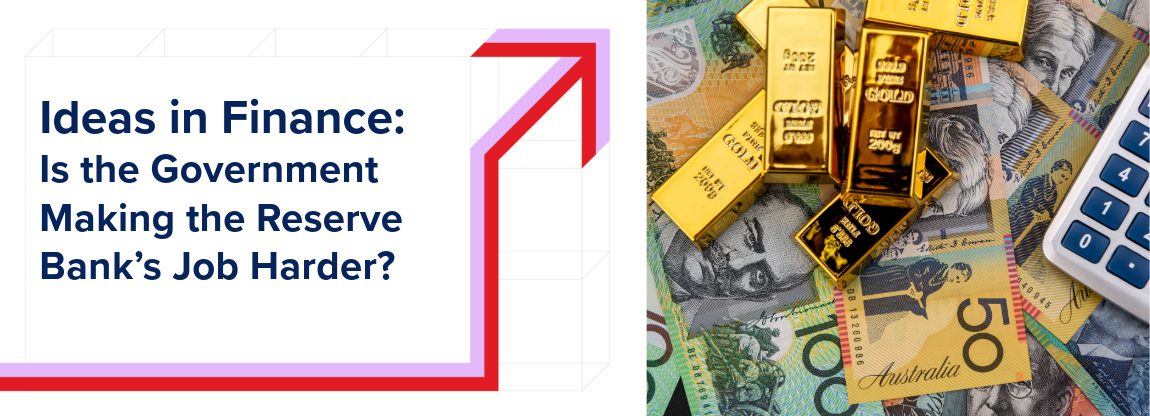Is the Government Making the Reserve Bank’s Job Harder?
Published 30 August 2024
By Dr Peter J Phillips, Associate Professor (Finance & Banking) University of Southern Queensland


There’s been a lot of commentary recently about government spending making the Reserve Bank’s battle against inflation harder and, therefore, keeping interest rates higher. The idea is that more government spending, including the wages of public sector employees, puts extra money into the economy and competes with everyone else for limited goods and services. As such, the government should be a smaller part of the economy. It’s hard to argue against the logic, but there are a few twists that emerge when you take a closer look at the data: (1) government spending has been a significant part of the economic landscape (and possibly the inflation problem) in the West since the 1960s; and (2) central banks, including the RBA, have played a role in perpetuating this situation.
Without the help of central banks, governments would have to rely on savers buying government bonds, or they would have to raise taxes (or tariffs etc.) to pay for government programs, or they would have to cut some programs to pay for others. The question of government spending being too great a proportion of the overall economy is becoming a hot topic around the world. Expect a lot more to be said about it. Here, we delve into some of the data.
In macroeconomics they teach you that the total output (GDP) of the economy is equal to the sum of consumption (C), investment (I), government spending (G), and net exports (NX) (exports minus imports). That’s C+I+G+NX. Ideally, spending by consumers on goods they want, investment in capital equipment and new ideas, and sales of exports greater than purchases of imports would be the drivers of the economy, with G being a relatively small part. If that’s the situation you’d prefer, you would be disappointed, not just now, but since about 1965, and especially since 1980.
According to the International Monetary Fund (IMF), Australian government spending was 38 percent of GDP in 2022. That’s 5 points higher than China, and 2 points higher than Russia. Like most Western countries, government spending as a percentage of GDP increased a lot during the period 1960 to 1980. In 1960, government spending in Australia was around 11 percent of GDP. By 1980 it was over 33 percent. It has remained above 30 percent ever since. It is worth noting that there was a gradual decline between 1985 and 2008, from 38 percent to about 33 percent, apart from a temporary spike back to 38 percent during the 1991 recession. Following the 2008 financial crisis, however, there was a steady increase from 33 percent back towards 38 percent, then a big jump to about 44 percent during the pandemic before a decline back to 38 percent.
The scale might surprise some people. For a long time, more than one-third of the Australian economy has been made up of government spending. And, interestingly, the pattern of Australian government spending as a proportion of GDP has tracked almost exactly the trend in the United States. If 38 percent seems high, though, consider France, where government spending is 58 percent of GDP. In Germany, 49 percent. Sweden, 47 percent. Again, while the values are different, the trends match the United States almost exactly. There was big growth between 1960 and 1980, then that relatively high level has been maintained.
Let’s consider a few facts about government revenue and expenditure in Australia before tracking down a reason for this shared pattern across the West.
First, how much money does the Australian government get and where does it get it from? According to the Australian Bureau of Statistics, across all levels of government, about $900 billion in revenue was raised in 2022-23. About $700 billion of this came from taxation. About 20 percent of the tax revenue came from company tax, another 15 percent from personal income taxes, 14 percent from the GST, and 18 percent of fuel excises.
Where does the money go? Like most countries, the biggest items in Australia’s government spending are “social protection services” (social security and welfare) and health (Medicare). These together make up about half of total government expenditure.
The total “social protection expenses” are about $250 billion p.a., broken down as follows: about $70 billion on disability, $96 billion on old age pension, $48 billion on family/children (e.g., tax offsets), $10 billion on social exclusion, and $25 billion on other.
The total “health” expenses are about $180 billion, broken down as follows: $21 billion on medical products, appliances, and equipment, $62 billion on hospitals, $12 billion on public health services, $53 billion on community health services, and $33 billion on other.
Education is the next biggest expenditure item at about 15 percent of the total, “general public services” 11 percent, defence at 5 percent and bunch of others in single digits making up 100 percent.
Of course, when expenditure is greater than revenue, the government borrows. The Australian government is currently carrying about $780 billion in debt. This costs about $25 billion p.a. in interest. That’s about 3 percent of the total going on interest.
What about government workers? In 2024, there were a total of 14.4 million people employed in Australia. Government employees amount to around 2.4 million people or roughly 16 percent of the total number of people employed in the country. The total wages paid to public sector workers was $214 billion in 2023. The breakdown is as follows: $142 billion at state government level (1.8 million people), $33 billion at Commonwealth level (350,000 people, including defence forces), $15 billion at local level (208,000 people), and $16 billion at universities (about 130,000 people).
If you’re going to argue that government spending is making the RBA’s job more difficult, there is certainly enough material to make a case. But it goes back a lot further than the past year or two. And there’s a twist to the story. That is, central banks have made the government’s ability to spend easier. Once you delve into the matter, I think the most interesting fact to emerge from the data concerns the global trends in the West since 1960. If you go to the International Monetary Fund and build a chart using their data, you can see how well the trends line up across nearly every Western country starting in 1960, and especially between 1965 and 1980. What happened in the mid-1960s that could foster the conditions necessary for a simultaneous and substantial increase in government spending as a proportion of GDP across the West?
The answer is the beginning of the end of the Bretton Woods monetary system and abandonment of the gold standard. This released the shackles from monetary and fiscal policy. Government spending assisted by central banks was a new force unleased on the global economic system. Inflation has been persistent ever since. In Australia, $10,000 of goods in 1966 would have cost $30,000 in 1980, $66,000 in 1990, $82,000 in 2000, and today cost $155,000. A similar pattern occurs in the United States. $10,000 of goods in 1913 in America would have cost $32,000 in 1966. That is, it took more than 50 years to triple. It would almost triple again between 1966 and 1980, with $10,000 of goods in 1966 costing $26,000 in 1980. Then $40,000 in 1990, $53,000 in 2000, and $93,000 in 2023. As you can see, the inflation problem, the declining real value of a dollar across many different economies, is not getting better as time goes by. Which is why people are going to keep talking about it.
Discussion Question
How do central banks facilitate government spending?
Read other posts
Why you should study Finance and Economics in the 21st Century
From Chicago to New York: Futures Trading and Microwave Popcorn
Basketball, Fund Managers, and the Hot Hand
The French Connection in Finance Theory
The Road to Cryptocurrency, Instalment # 1
The Road to Cryptocurrency Instalment #2
The Road to Cryptocurrency Instalment #3
The Road to Cryptocurrency Instalment #4
The Road to Cryptocurrency Instalment #5
The Road to Cryptocurrency Instalment #6
The Road to Cryptocurrency Instalment #7
Imagination and the Future of Cryptocurrency
Bigger Than FinTech: The Less Obvious Innovation Transforming Finance
NFTs: A Brave New World for Artists?
Sometimes, Inflatoin is the Only Way Out
I “Fink” Bitcoin Might Be a Good Idea After All
Bitcoin and Ethereum: Commodities or Securities?
